Comparing SEO and PPC is a lot like the Conner Mcgregor vs. Floyd Mayweather fight.
Two different marketing strategies. Two different sports.
We all know who won the boxing match but let’s be honest it wasn’t a fair comparison and the same can be said when you pair SEO vs. PPC, it’s not a fair fight.
They’re two very different marketing strategies, each with advantages and disadvantages. But before we dive into the pros and cons, let’s check out the stats on these fighters.
What Is SEO?
SEO or search engine optimization is the process of making your website, and web pages rank higher in organic search results.
SEO isn’t one tactic, but a collection of tactics used in tandem to improve site rankings.
You’ve got technical optimizations, content development, and link building – all of which are needed to implement an organic search strategy successfully.
The best way to start is to perform an SEO audit to figure out what your next steps are.
What Is PPC?
PPC or pay-per-click is an advertising model that lets companies buy their way to the top of search results by bidding on keywords.
On search engines like Google, advertisers specify how much they are willing to pay and are charged each time a user clicks on their ad.
As you can see in the example below, ads appear at the top of search results, before organic listings.
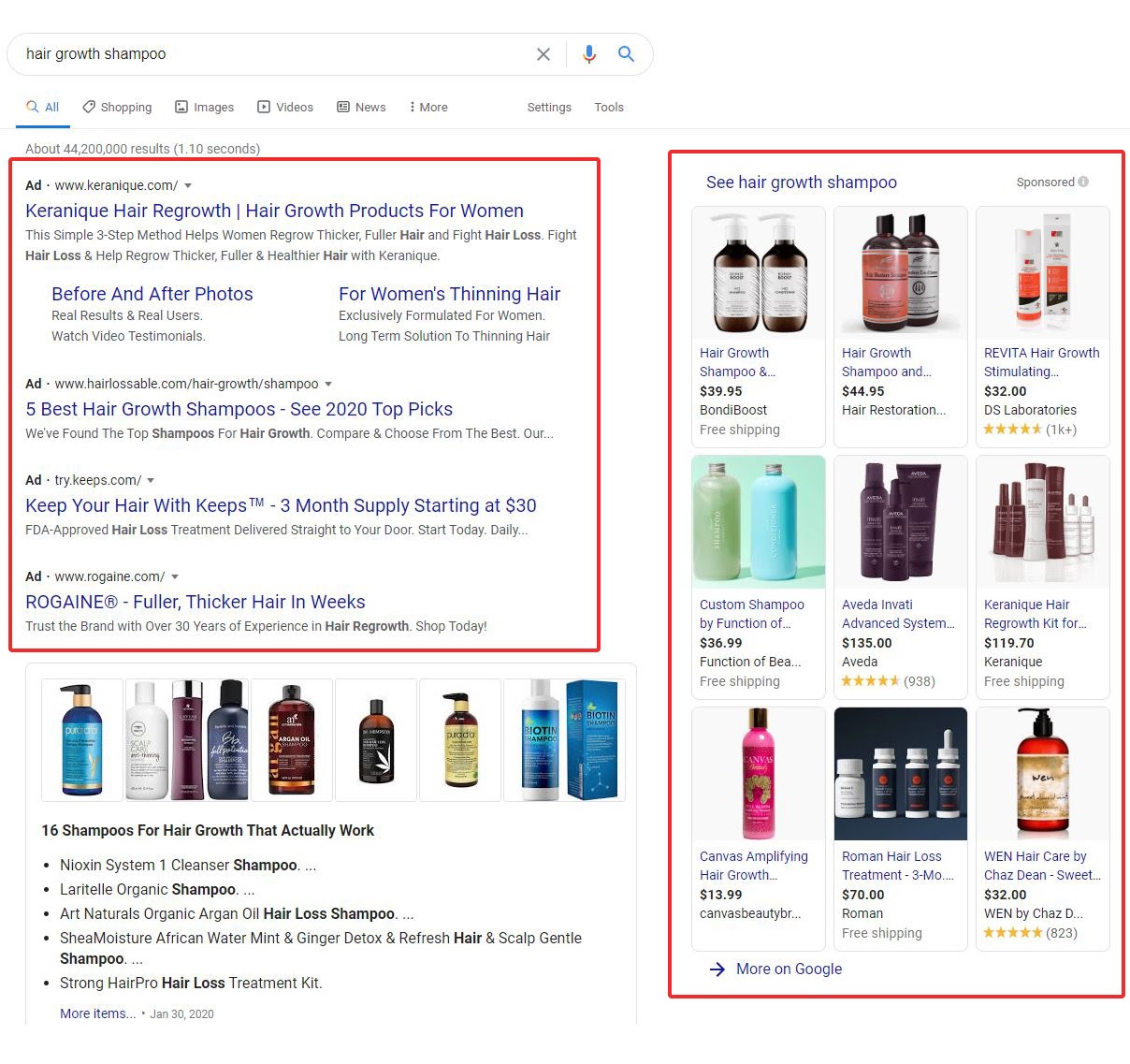
But that doesn’t mean PPC is the clear winner of this contest. There’s a whole list of pros and cons to consider before making your decision.
SEO or PPC?
Just by reading the above descriptions, you may have already spotted some clear benefits and disadvantages.
We mentioned that paid ads appear at the top of the search results above organic listings. Of course, the downside is that every click comes at a price, whereas organic traffic from SEO is free.
But I think we can agree that there’s a lot more to consider. So let’s explore the pros and cons of SEO vs. PPC.
SEO Pros
1. The snowball effect
When you build a snowball, it starts small, and you have to pack the snow on with your hands, but eventually, it gets big enough that you can roll it across the ground. At this point, the snowball is heavy enough that the snow on the ground sticks to it, and it gets bigger. Of course, the bigger it gets, the more snow it picks up, and the growth becomes exponential.
The same is true for SEO. When you start creating content and building backlinks, the growth is slow, and the work is difficult, but over time it gets easier, and the results improve. Eventually, the content you’ve created snowballs, and your site traffic steadily increases.
Let’s say you post one blog each week for a year, for example. Your first blog might only get 10 – 15 visitors each month. In fact, let’s say your first ten blogs only get 10 – 15 visitors each month. As you acquire links to these posts, your domain’s Authority Score increases, making future posts more visible. Thus, your next ten posts might average slightly more visitors, say 25 – 50 visitors per month. Now you’ve gone from 0 visitors to over 500 in less than six months.

In the graph above, you can see where the snowball effect really kicks in. After a few years of hard work, the SEO pays off, and traffic skyrockets. Like pushing your snowball down a hill, SEO efforts become more effective and easier to achieve over time.
2. Less expensive over the long run
If you do it all yourself, then SEO doesn’t cost anything other than your time and a few necessary tools like SEMrush. Even if you hand the work off to others, your costs can remain somewhat fixed as results improve.
The fixed costs of SEO, especially if you’re working with an SEO agency, are as follows:
Technical SEO Audits & Implementation – You’ll have to pay for somebody to audit your website, and for a developer to implement the changes, especially those which are complex.
Content Writing – One of the necessary pieces of a successful SEO strategy is content writing. If you don’t feel that you’re a good content writer, or you need help writing content for your site and guest posts on external websites, you’ll need to find an excellent writer to help accomplish your goals.
PPC, on the other hand, requires you to continually increase your ad spend to get more traffic.
3. Credibility and trust
When you create high-quality useful content around subject matters that your ideal customers enjoy reading about, you become a trusted resource. Additionally, every piece of content you write helps you drive traffic through SEO and proves that you’re an authority in your field.
There are many interesting credibility perks to strategically acquiring links with SEO. Let’s say you’re featured on a respected website like Forbes.com, for example. Now you have the opportunity to say, “As seen on Forbes.com” on your homepage.
SEO Cons
1. Results can take a long time
When starting an SEO campaign, realistic expectations are a must. It can take several months or even years to grow organic search traffic.
This is because SEO is centered around creating content for specific “target keywords” and even with a good team creating high-quality content, it takes time.
For example, let’s say you own a climbing gym and want to rank for the keyword “tower climbing certification.” First, you do a bit of research and discover that it’s not too difficult, and has a decent search volume.

Next, you decide to write an in-depth blog article about the topic and heavily promote your article. You even manage to score some high authority links, and within a few months, your article ranks in the top ten organic search results for your target keyword.
Sounds pretty awesome, right?
Here’s the thing, even if you manage to rank for one keyword or a handful of related keywords, you’ve still got a lot of work to do if you want to increase your site traffic. That means repeating this process over and over again until you rank for hundreds or thousands of keywords.
There’s no getting around it – this process is going to take a while. So if your goal is to promote an event or some other time-sensitive goal, then SEO probably isn’t a good option.
2. Complex and time-intensive
SEO is a bit more complicated and time-consuming than paid search. PPC has its own set of complexities, but considering I’ve done both, I’d have to say SEO takes the cake on this one.
For starters, there are two different types of SEO.
Technical SEO: Focuses on how your website is set up for search engines to read your content. This involves optimizing robots.txt, title tags, XML sitemaps, page speed, structured data, internal linking, and design elements to make your site easier for Google and other search engines to crawl.
Content Marketing: The process of strategizing, creating, and distributing content users find valuable. Many different types of content fall into this category, like videos, eBooks, blogs, free tools, infographics, guides, and lists. But it doesn’t stop there. After you’ve optimized your website and started creating valuable content, you’ll still need to build links. Link building almost makes the list as the third type of SEO, but we’ll throw it in the content marketing bucket for now.
The bottom line is you may not have the knowledge, time, or expertise to execute a successful SEO campaign all by yourself. Many companies that specialize in SEO have an entire team consisting of developers, graphic designers, copywriters, videographers, and analysts.
3. Requires paid tools
Ranking at the top of organic search results for any given keyword takes a lot of time and effort, as we’ve just described in the two previous sections. So you’ll want to pick your keywords wisely.
When it comes to organic rankings, all keywords have different levels of difficulty from very easy to downright impossible. They also have different search volumes – the estimated number of monthly searches for a particular keyword.
You’ll want to consider both of these factors when weighing your options. If a keyword has a high difficulty and low search volume, it may not be worth the time and effort.
Using the keyword analytics tool, you can easily find search volume and keyword difficulty for any keyword.
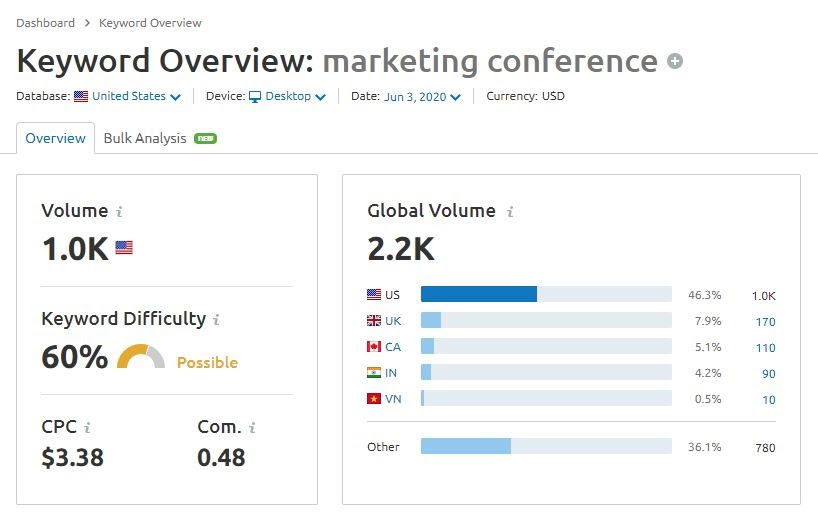
But you won’t be able to see these metrics on your own, which really makes tools like this a necessity if you’re serious about SEO.
PPC Pros
1. Instant results
Unlike SEO, PPC starts working within a few minutes from the time you start a campaign. Your ads will be appearing in search results for your target keywords almost immediately. This means you can start getting leads and sales immediately too.
For example, let’s say you own an auto garage and want to get more oil change customers. First, you can use the Keyword Magic Tool to find the best keywords to bid on. In addition to an entire list of keyword ideas, you’ll find the term with the highest search volume and get a cost per click estimate.
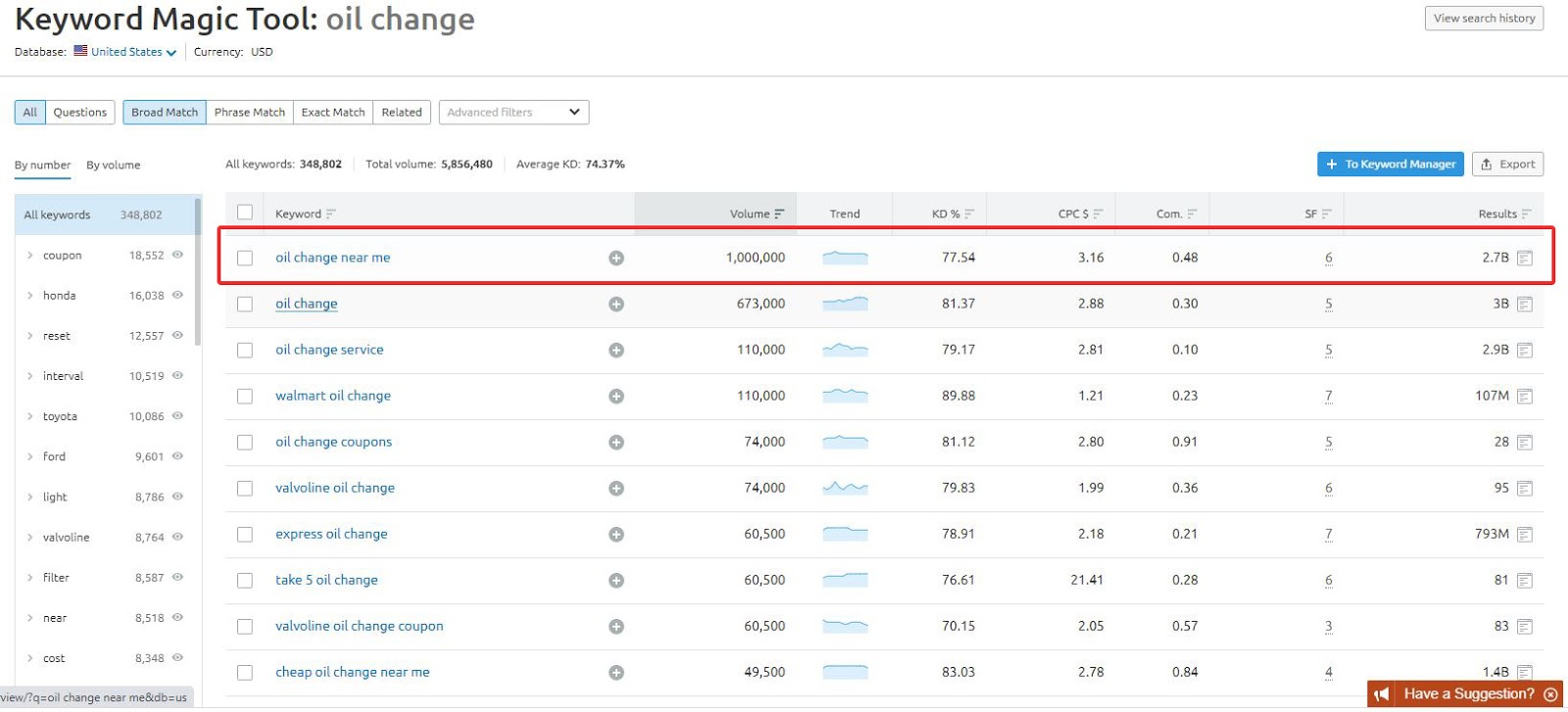
In this example, “oil change near me” has the highest volume and a pretty low CPC at around $3.16.
After you decide on a handful of keywords, you can plug them into Google Ads and start ranking right away.
2. Laser-focused targeting
PPC for local businesses is especially effective because you can target people within a certain radius around your business location.
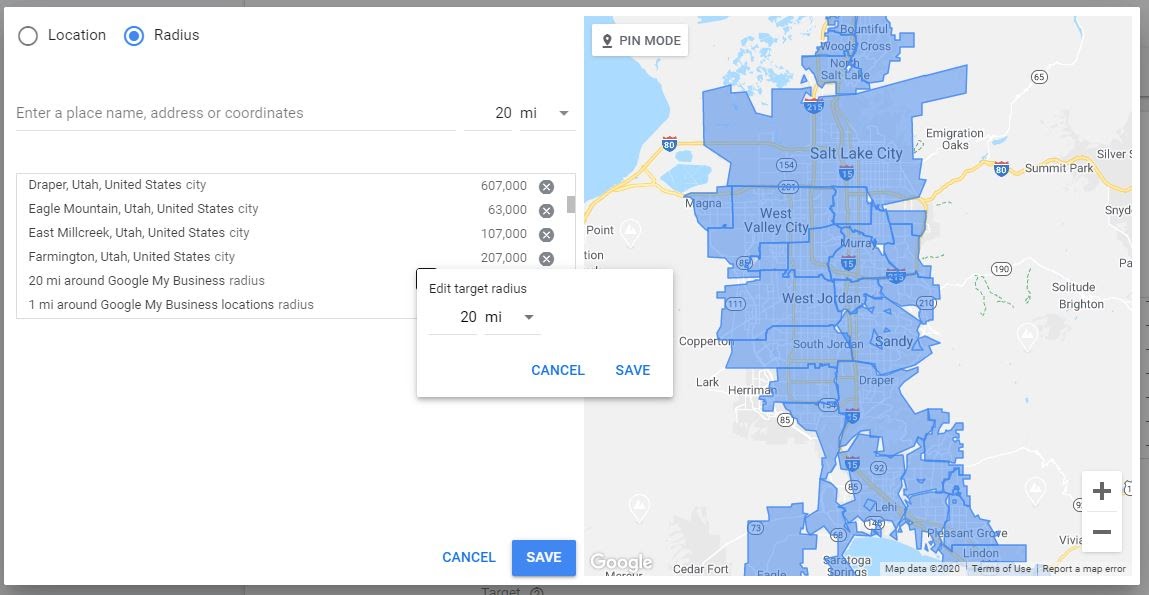
You also have access to a long list of additional targeting options, like demographics, interests, and more. This advanced level of targeting allows you to pick and choose who visits your website – often leading to higher quality traffic.
And of course, once you get them on your website, you can follow them around with retargeting ads to get them to come back and make a purchase.
3. Marketing intelligence
Pay-per-click advertising is fast and accurate, and the reporting and data are no exception. Google Ads, Facebook Ads, and most other ad platforms let you track exactly how much you pay per result, whether that be a phone call, lead, or a purchase.
If you’re running an eCommerce business where customers can purchase directly from your website, you can take advantage of even more detailed tracking.
Return on ad spend (ROAS) tracks how much revenue your ads produce in comparison to cost. This makes it easy to justify the amount of money you spend.

In the example above, the ROAS is 12.40, meaning for every $1 spent on ads, they’re making $12.40 in return. Pretty awesome, right?
Unfortunately, tracking return on investment is a bit trickier with lead generation, but you can implement advanced features like hidden form fields for more exact attribution. This can help you pinpoint the exact keywords and ads that produce your most profitable leads.
The best part about all this data is how quickly you can use it to your advantage. You can set up A/B tests to compare ad performance in real-time and quickly figure what works and what doesn’t.
PPC Cons
1. Pay to play
Remember the old adage you need to have money to make money? PPC is a great example of this.
You need to have money to invest in PPC. Not only that, but you’ll have to be okay with not being profitable for the first few weeks if not months until you’re able to optimize your campaigns.
But even if you have money to invest and the skills and patience to optimize your campaigns, you might still run into a wall – a very expensive wall. Some industries are extremely competitive, and that drives the cost per click (CPC) higher.

For example, if your a law firm that specializes in accident cases, you can expect to pay $100 or more per click.
If you think that’s nuts, then imagine how much it costs to actually acquire a new client with these keywords.
Let’s run the numbers.
Assume $125 cost per click, a 5% conversion rate, and an 80% close rate – that’s a $3125 cost for one new client.
2. Rising costs and competition
No matter how precisely you optimize your campaigns, you may still see a steady rise in CPC. As your competition optimizes their campaigns and increases bids you’ll be forced to pay more to compete.
This never-ending back and forth forces advertisers to place their focus on conversion rate optimization (CRO). Ultimately the business that converts more visitors and closes a higher percentage of sales will be more profitable. In turn, higher profits allow for higher costs per click, and more expensive customer acquisition costs.
3. Comparison shoppers
A comparison shopper (also known as a price shopper) is someone who is interested in a particular product or service but wants to compare many different offers before making a purchase.
These types of customers take longer to close and will compare your offering with several of your competitors. After careful review, they typically choose the product or service they deem most cost-effective.
Comparison shoppers aren’t the ideal customer.
Unfortunately, PPC ads give comparison shoppers exactly what they are looking for – the ability to quickly contact each company and compare offers.
These types of customers are typically more price-sensitive and have less brand loyalty. This means they’ll choose the company with the lowest advertised prices regardless of other factors.
SEO and PPC
Instead of asking which is better, you should ask which is better for my business, but even then, the answer isn’t simple. The best strategy for your business will depend on what you’re trying to accomplish, and many times will end up being a mix of both PPC and SEO.
Here’s a look at some of the unique benefits of using SEO and PPC in tandem.
Data Synergy
As we mentioned previously, PPC provides you with instant feedback whereas SEO doesn’t.
So why not use PPC to inform your SEO strategy?
After all, SEO is a long time-intensive process so you’ll want to pick your keywords wisely. You can test conversion potential for your target keywords using PPC before making any long-term SEO commitments. This will prevent you from creating a bunch of content around a keyword only to find that it produces low-quality traffic.
You could also take a sneak peek at the paid keywords your competitors are bidding on.
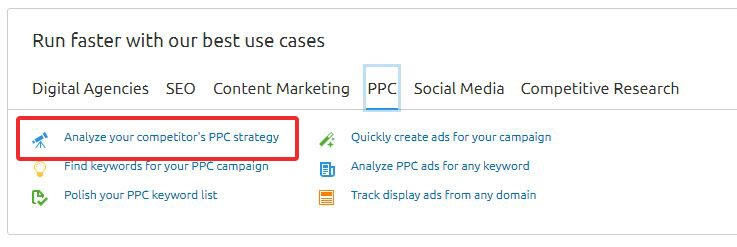
Keywords that your competitors consistently bid on present an opportunity for you organically and via paid search.
You could also use paid traffic to A/B test landing pages. Then transfer your learnings and apply them to pages that rank organically for the same terms.
Link Acquisition
PPC can help users find your content before it ranks organically and help you build backlinks to improve your SEO.
The best way to put this technique to use is to write a post or create a content piece that focuses on a keyword with high search volume. If you’re not sure where to start, you can use the keyword magic tool to help hunt down the right keyword. To speed up your search it even lets you set filters to hide low volume keywords.

After you’ve picked a keyword and created the content, you can use Google Ads to promote the article. This way, even though it doesn’t rank organically, it can be found by searchers. Some people who find your content via paid search will link back to your article, which, in turn, will help the page rank higher in organic search.
Alternatively, you may have a unique piece of content that ranks for its target keyword, but has little to no search volume. In this case, Facebook Ads are a great way to get your content in front of your target audience.
Retargeting Potential
Organic content isn’t always built around keywords with high commercial intent. This means a lot of your SEO traffic is consuming your content, benefiting from it, and never returning to make a purchase.
The good news is, you can fix this problem with retargeting.
Retargeting is a PPC tactic that lets you serve ads to past website visitors. That means you can bring those blog readers and window shoppers back to your site and get them to convert.
It’s super effective because the visitors are already familiar with your brand, and you’ve already provided them value. In fact, if there’s only one tactic that you take away from this article, let it be this.
Final Thoughts on SEO and PPC
Some early-stage businesses may be better off starting with SEO, while others would do better with PPC.
For example, it’s better to start with PPC when you have a new or innovative product. Because people aren’t searching for what you have to offer, SEO won’t help you much. In this scenario, you’ll want to build brand awareness and drive sales with PPC.
However, if you’re in a well-known and highly competitive industry, then PPC advertising will be costly, and it adds little differentiation from your competitors. In this case, SEO and high-quality content will be your weapon of choice.
The bottom line is, one isn’t better than the other and they both work better when used together.


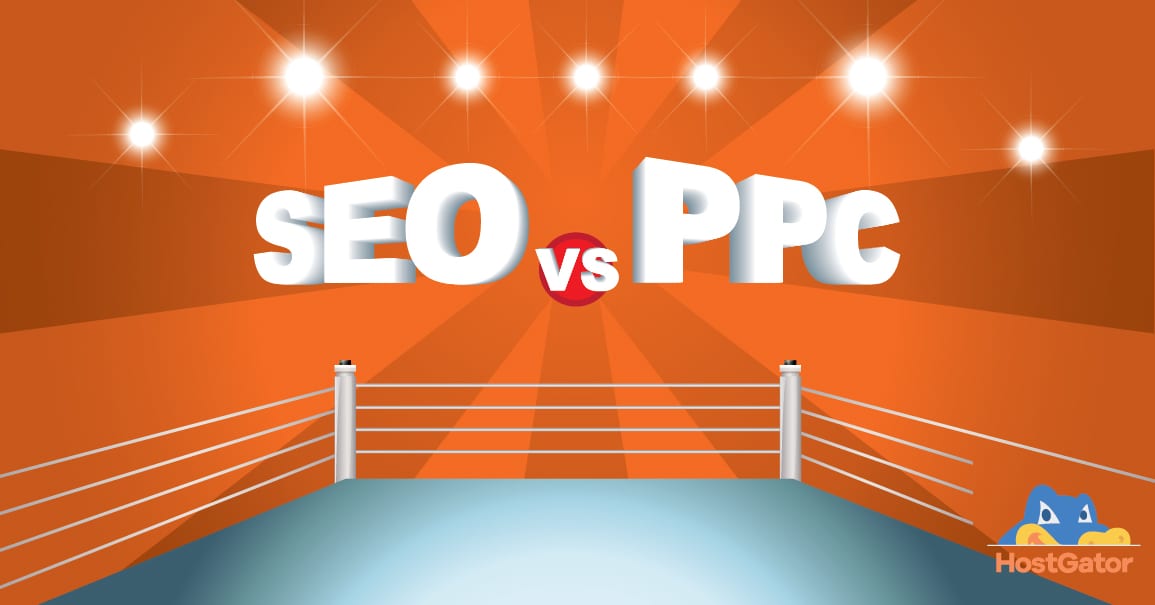

![Yes, B2B Websites Can Use Personalization Too [Here’s How]](https://mdvirtue.com/wp-content/uploads/2022/02/Yes-B2B-Websites-Can-Use-Personalization-Too-Heres-How-400x250.jpeg)

0 Comments